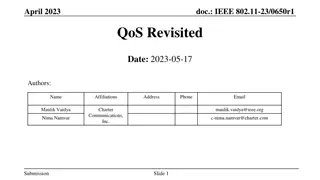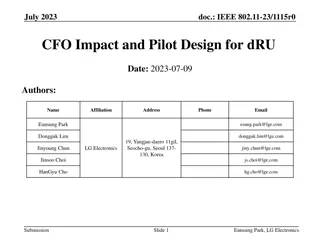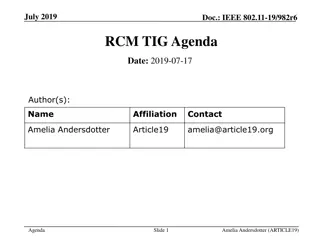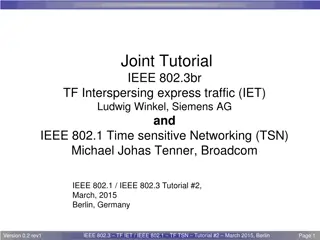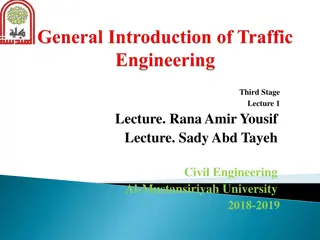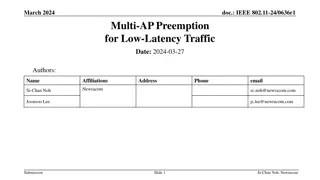IEEE 802.11-21/1115r0 Traffic Prioritization Summary
The presentation discusses traffic prioritization rules during restricted TWT SPs in IEEE 802.11-21/1115r0. It revisits the topic to address pending items related to traffic restriction or prioritization, including specific rules for APs, scheduled STAs, supporting non-AP STAs, and non-rTWT STAs. Considerations include meeting the purpose of rTWT, utilizing additional resources efficiently, and ensuring power saving for STAs. Fairness versus differentiation in traffic restriction over rTWT SPs is explored in terms of meeting latency-sensitive traffic delivery agreements.
Download Presentation

Please find below an Image/Link to download the presentation.
The content on the website is provided AS IS for your information and personal use only. It may not be sold, licensed, or shared on other websites without obtaining consent from the author.If you encounter any issues during the download, it is possible that the publisher has removed the file from their server.
You are allowed to download the files provided on this website for personal or commercial use, subject to the condition that they are used lawfully. All files are the property of their respective owners.
The content on the website is provided AS IS for your information and personal use only. It may not be sold, licensed, or shared on other websites without obtaining consent from the author.
E N D
Presentation Transcript
IEEE 802.11-21/1115r0 July 2021 Traffic Prioritization During the Restricted TWT SPs Date: 2021-07-25 Affiliations Address Phone email Name Chunyu Hu chunyuhu07@gmail.com 1 Hacker way Menlo Park, CA M. Kumail Haider Facebook Inc. Chitto Ghosh Submission Slide 1 Chunyu Hu et al.
IEEE 802.11-21/1115r0 July 2021 Abstract Discuss the traffic prioritization rules during the restricted TWT SPs Submission Slide 2 Chunyu Hu et al.
IEEE 802.11-21/1115r0 July 2021 Background D1.1 subclause 35.6.2 (Restricted TWT setup procedure) specifies TID(s) as traffic associated with the rTWT membership between the rTWT scheduling AP and the rTWT scheduled STAs During the discussion on the rTWT setup procedure (11-21/462), the topic on traffic restriction or prioritization didn t reach conclusion or have much time to address. This presentation revisits the topic in order to resolve this pending item and related CC36 CIDs: o 4768, 4775, 4776, 5874, 6506, 4121, 5728, 6511, 7432, 7634, 5775, 6546, 5664, 4586, 4587, 4588 Submission Slide 3 Chunyu Hu et al.
IEEE 802.11-21/1115r0 July 2021 Problem Notation: o TIDs_L denotes TIDs specified by the rTWT setup procedure o TIDs_L{AP, STA_x} is the TID set specified by the rTWT setup procedure between AP and STA_x During the restricted TWT service periods (SPs), is there any restriction to the type of traffic to be delivered? o Is it a restriction or prioritization ? o If any, what are the specific rules for: rTWT scheduling AP s transmission? rTWT scheduled STA s transmission? rTWT supporting non-AP STA (but not members) s transmission? non-AP STAs that are not rTWT STAs transmission? Submission Slide 4 Chunyu Hu et al.
IEEE 802.11-21/1115r0 July 2021 Fairness versus Differentiation There are many factors to take into account when restricting/limiting/prioritizing the traffic over the rTWT SPs: o Meet purpose of rTWT: agreement between AP and STAs to delivery latency sensitive traffic when targeted time to meet starts For participating AP and STAs, they would and should deliver the traffic of TIDs_L first among any other pending traffic o The rTWT SP may have additional resource in frequency/spatial resources: MU-MIMO, OFDMA E.g. rTWT scheduled STA supports bw80 only and AP operates at BW 160. The upper bw80 would ve been wasted if we don t allow AP to schedule DL traffic to other STAs out of rTWT members. E.g. rTWT scheduled supports NSS=1 and AP supports 4x4. The other three streams would ve been wasted if we don t allow AP to schedule DL traffic other STAs using MU-MIMO Same for DL and UL when MU-MIMO/UL-OFDMA allows more opportunities to share resources o Power saving: rTWT STA may complete transmitting TIDs_L {AP, STA} before the SP finishes and it has frames of other TIDs pending at itself/AP. It s more power efficient to stay awake to tx/rx them. o Fairness: while giving privilege (albeit limited) to rTWT associated traffic, other STAs hope to get fair chance to rx traffic from AP e.g. To balance all these factors, prefer to prioritizing traffic in TIDs_L rather than restricting traffic to be delivered in rTWT SPs only within TIDs_L among rTWT scheduling AP and scheduled STAs Submission Slide 5 Chunyu Hu et al.
IEEE 802.11-21/1115r0 July 2021 Traffic Prioritization Rules for rTWT SP Discuss two types: o Trigger enabled rTWT SPs o Non-trigger enabled rTWT SPs Discuss the rules for UL / DL traffic of rTWT member STAs, and non- rTWT member STAs Submission Slide 6 Chunyu Hu et al.
IEEE 802.11-21/1115r0 July 2021 Trigger-enabled rTWT SPs: UL Traffic (1) For rTWT scheduling AP: what to transmit? o Trigger frames (all supported types): basic and BSRP that are for data frame delivery or supporting it (inquiry buffer status), and other types o Basic trigger: need to trigger selected TIDs in TIDs_L General rule: shall prioritize to trigger MSDUs of TIDs_L from rTWT scheduled STAs over {other TIDs of the rTWT scheduled STAs and any MSDUs of other STAs} o BSRP: similar to above General problem: o Basic trigger specified <preferred AC> and doesn t specify target TID(s) o BSRP doesn t specify which TID nor the response as BSR HE control field directly answer the question: buffer status for specified TID o Proposal: 1) Amend basic trigger to trigger MSDUs of specified TID(s) 2) Amend BSRP to inquiry buffer status of specified TID(s) 3) Design BSRP response to provide buffer status for specific TID(s) o Following discussions assume some form of solution to this problem is there to focus on traffic prioritization rules Submission Slide 7 Chunyu Hu et al.
IEEE 802.11-21/1115r0 July 2021 Trigger-enabled rTWT SP: UL Traffic (2) For rTWT scheduled STAs: what to respond? o Responding to BSRP: Provide buffer status for specified TID(s) (which are supposedly associated with the rTWT membership), and optionally provide buffer status for other TID(s) If the buffer status for TIDs_L indicates empty buffer or rTWT scheduled STAs didn t include buffer status for TIDs_L in responding frame, it is interpreted by the rTWT scheduling AP that the rTWT scheduled STA doesn t have more pending buffer of TIDs_L in current rTWT SP. AP may terminate the rTWT SP with this STA using early termination signaling Note: failing to receive BS response for a TID doesn t mean the transmitter side didn t include them (can be due to CRC error) unless AP knows it receives all MPDUs in the responding A-MPDU correctly Submission Slide 8 Chunyu Hu et al.
IEEE 802.11-21/1115r0 July 2021 Trigger-enabled rTWT SP: UL Traffic (3) For rTWT scheduled STAs: what to respond? o Responding to basic trigger (or its variant that specify target TID(s)) in order of (permitted by allowed transmission time per UL length): Pending MSDUs for the triggered TID(s) If there is no more pending MSDUs of the triggered TID, REQUIRED to indicate empty buffer status using HE-control in QoS-Null Pending MSDUs of TIDs_L but not trigged TID Pending MSDUs of TIDs not in TIDs_L, if any If the rTWT scheduling AP receives explicit empty buffer status indication for all TIDs in TIDs_L, then AP may terminate the rTWT SP with the corresponding rTWT scheduled STA as needed (if there is enough remaining time) o Fairness problem: a rTWT scheduled STA can continue respond to AP with TIDs not in TIDs_L and don t give empty buffer status indication for TIDs_L to get advantage over other traffic/STAs Submission Slide 9 Chunyu Hu et al.
IEEE 802.11-21/1115r0 July 2021 Trigger-enabled rTWT SP: Triggering Order (Proposal) the following rules define the order of {triggered STA, traffic identified by its TID) contained in the basic trigger frame or its variant transmitted by a rTWT scheduling AP during rTWT SPs: o Consider three sets of (STA, TID): Set 1: STAs are rTWT scheduled STA (and haven t terminated their respective SPs) and haven t indicated empty BS for all its TIDs in TIDs_L Set 2: STAs are rTWT scheduled STA in PS (and haven t terminated their respective SPs) and haven t indicated empty BS for all its TIDs in TIDs_L Set 3: STAs are rTWT scheduled STAs but not in set 1 nor 2, or STAs are not rTWT scheduled STA for current SP o Rule: AP should choose the (STA, TID/AC) to trigger first from set 1, next set 2 and lastly set 3 in priority while trying to maximizing the spatial and frequency reuse in the UL TB PPDUs Submission Slide 10 Chunyu Hu et al.
IEEE 802.11-21/1115r0 July 2021 Trigger-enabled rTWT: DL Traffic AP shall prioritize any pending MSDUs of TIDs_L to rTWT scheduled STAs over any other TIDs or to other STAs in the current rTWT SP The prioritization order is similar to triggering order described in previous slide: o Consider three sets of (STA, TID): Set 1: STAs are rTWT scheduled STAs (and haven t terminated their respective SPs) and AP has pending MSDUs of TIDs_L for them Set 2: STAs are rTWT scheduled STAs (and haven t terminated their respective SPs), and AP doesn t have any pending MSDUs of TIDs_L for them Set 3: STAs are not rTWT scheduled STAs for current SP, or STAs are rTWT scheduled STA but their respective SPs have been terminated o Rule: AP should choose the traffic to transmit first from set 1, next set 2 and lastly set 3 while trying to maximizing the spatial and frequency reuse in DL SU or MU PPDU scheduling Submission Slide 11 Chunyu Hu et al.
IEEE 802.11-21/1115r0 July 2021 Rules (Or No Rules) for Other STAs The non rTWT STAs for current rTWT SP can access the channel following the baseline EDCA and MU-EDCA rules, except that o Additional channel access rules specified in subclause 35.7.3 per D1.1 Such STAs, when gaining channel access, can transmit traffic of their choices Submission Slide 12 Chunyu Hu et al.
IEEE 802.11-21/1115r0 July 2021 Non Trigger-enabled rTWT SPs DL traffic prioritization: same as trigger-enabled rTWT SPs UL traffic prioritization: o rTWT scheduled STAs shall first schedule the transmission of MSDUs of TIDs_L. o If there is no more pending frames of TIDs_L, the rTWT scheduled STAs shall either indicate to AP its readiness to terminate the SP, or request to terminate the SP, or stop scheduling other data frame transmission until the end of the rTWT SP or the rTWT SP is terminated Submission Slide 13 Chunyu Hu et al.
IEEE 802.11-21/1115r0 July 2021 Summary Discuss the gap in trigger frame functionality: lack of TID based triggering and corresponding response Discuss the rules for prioritizing DL/UL traffic during the trigger-enabled and non-trigger-enabled rTWT SPs Submission Slide 14 Chunyu Hu et al.




